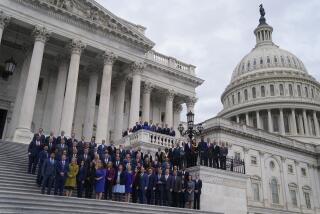A Californian Heads Texas’ King-Sized Capitol Face Lift
- Share via
AUSTIN, Tex. — Bonnie Ann Campbell, its 30-year-old curator, observed of her favorite Texas structure: “It’s a fabulous Capitol. What’s so amazing is that 100 years ago this huge building was plunked in the middle of Austin, a tiny frontier settlement.
“It’s a testament to what Texas is all about: bigger and better,” said Campbell, a Californian, a graduate of Alhambra High School and Occidental College.
As curator, she has been responsible for three years for all the paintings, statuary and furnishings on the grounds and in the building that house the Lone Star State’s seat of government.
She held the same position, beginning at age 23, in Sacramento from 1981 to 1985, when California’s Capitol underwent major restoration.
Since 1985, the 392-room Texas Capitol has been in the throes of renovation--new carpeting, drapes, furnishings--and Californian Campbell is playing a leading role in the work.
“I’m doing all the curatorial work, such as cataloguing everything in the building, doing research on each item and acquiring additional antique furnishings or reproductions that are appropriate to the style and period of this building,” she said.
She has traveled nationwide buying chairs, sofas, tables, lamps to mix in with the 400 original pieces of furniture in the immense 556x288x308-foot Capitol. It was the largest Capitol in the nation when dedicated on May 16, 1888.
Fascinating Features
Campbell knows the Renaissance revival building inside and out. She knows it better than just about every Texan. On a tour, she pointed out many of its fascinating features.
It has a Texas imprint everywhere. Texas is spelled out in light bulbs in the House and Senate chandeliers and in a gigantic star in the Capitol dome.
The familiar cast of Texas characters are depicted in statues and paintings in the foyer, in the legislative chambers, governor’s office, elsewhere in the building. There are people like Stephen F. Austin, the father of Texas; Sam Houston; David Crockett; Lyndon Baines Johnson; Sam Rayburn; John Nance; “Cactus Jack” Garner; Barbara Jordan; and two Texas governors, James E. (Pa) Ferguson, who served from 1915-17, and his wife, Miriam A. (Ma) Ferguson, who was chief executive from 1925-27 and 1933-35.
Campbell stopped by a large painting of a woman hanging on a Senate wall and said: “Here’s someone known to most Texans but unknown outside the state. Strange as it may seem, she never set foot in Texas. Now, she’s buried in the Texas state cemetery not far from the Capitol.
“Her name was Joanna Troutman. She designed the Lone Star flag, a white star on a blue vertical field with two horizontal bars, one red, one white. She’s the Betsy Ross of Texas.”
Also in the Senate are two large murals by H. A. McCardle, who lived from 1836 to 1908. It took McCardle 40 years to complete “Dawn at the Alamo” and “Battle of San Jacinto.” In the south foyer is William Henry Huddle’s famous “Surrender of Santa Anna” mural, showing the Mexican general surrendering to the wounded Texas commander Sam Houston, who was lying on the ground recovering from being shot in the foot.
Goddess of Liberty Replaced
The first phase of the restoration was a replacement of the deteriorating Goddess of Liberty statue atop the Capitol dome, Campbell explained.
The statue of the robust “Lady on the Roof”--a 15-foot, 7 1/2-inch figure of a woman in flowing robes, holding a sword in her right hand and a gold star in her left hand held high over her head--towered above the dome for 97 years. It was exposed to blistering heat and bitter cold.
The 3,000-pound statue was plucked off the dome by a Texas National Guard Chinook helicopter in November, 1985, and replaced by a replica six months later.
Centennial Celebration
Last month, a three-day centennial celebration of the Capitol included a big parade, a centennial ball in the rotunda and the reading of Temple Houston’s “This Noble Edifice” dedication speech.
Houston, the youngest son of Sam Houston and then a state senator, declared: “This building fires the heart and excites reflections in the minds of all. Here glitters a structure that shall stand as a sentinel of eternity.”
“Spoken with the exuberance of a true son of the Texas soil,” said Campbell, the transplant now having a fine time helping to restore the stately structure to approximately what it was like when Houston delivered his speech a century ago.
More to Read
Sign up for The Wild
We’ll help you find the best places to hike, bike and run, as well as the perfect silent spots for meditation and yoga.
You may occasionally receive promotional content from the Los Angeles Times.






